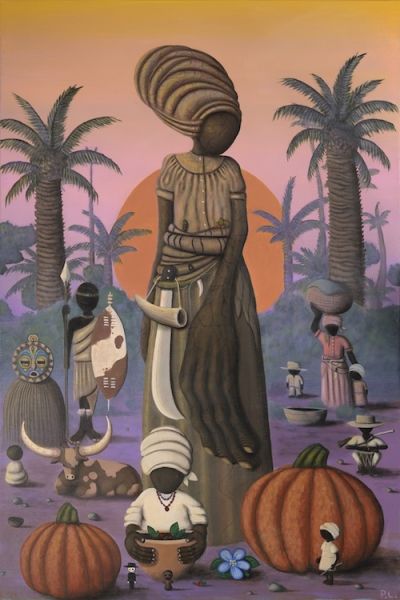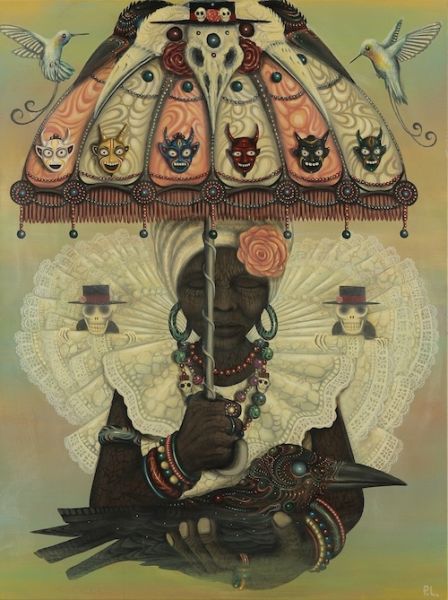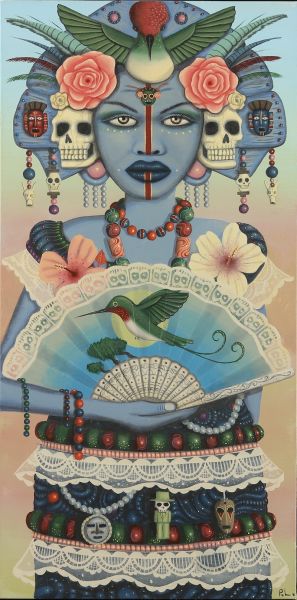In Jamaican folklore, the country’s only female national hero is the powerful Queen Nanny. Legend has it that Queen Nanny led a group called the Maroons, who escaped slavery and created their own civilization in the mountains. They descended the hills to free other slaves before burning plantations to the ground.
After repeated conflict with the British, Queen Nanny was moments from giving up when her ancestors came to her, delivering pumpkin seeds to plant as food, sustaining the Maroon community which continues to inhabit Jamaica to this day.

Stories like this are the inspiration behind the artwork of Oakland-based painter, Paul Lewin.
“My mom would tell me stories about back in the old country where she grew up in Jamaica, how they would gather kids around and tell them Jamaican folklore stories,” says Lewin in his home studio.
“I want each piece to tell a story in the same way that the stories have been passed down for generations, dating all of the way back to Africa. I want to continue that tradition of storytelling in my work.”
Lewin was born in Jamaica and relocated to Miami with his family when he was five. Trying to integrate into American culture while also finding himself a part of an “alternative” or punk scene led to the creation of a world in which all of his identity realities exist; a continuum of his personal experience.
Lewin’s series, titled “Roots of the Cotton Tree” for the lore around Jamaica’s sacred silk cotton trees, embodies the sensation of simultaneously stepping back in time and into the future. Rooted in the tales of his native Caribbean along with elements of surrealism and sci-fi (he’s a huge Octavia Butler fan) his creations are also inspired by the work of animation master Hayao Miyazaki.

The painstakingly detailed lace, carnival-inspired jewelry and intricate symbolism in his paintings bring to life stories waiting to be told. A self-taught artist who spent three years researching the folklore of his native Jamaica before immersing himself in this latest project, Lewin says his paintings tend to take on a life of their own; he’s never quite sure what the story is until a piece is completed. The work is particularly powerful in regards to race and gender representation.
“Dealing with race while I was growing up and watching all of these sci-fi movies and fantasy movies it was rare to ever see a person of color. Not just in movies, but you didn’t see them in art — in historical surrealist art — that art just wasn’t shown to us,” he says. “Race plays a role in my work in that way; I’m painting the images I always wish I could have seen growing up with people of color in nontraditional settings.”

Most notably, the female characters in Lewin’s work are fierce, not sexualized in the manner of traditional fantasy or sci-fi. The elders he paints embody wisdom and authority.
“I grew up with a lot of sci-fi and fantasy art. Growing up I loved it and thought it was the most amazing thing in the word and then I kind of veered away from it as I got older,” he says.
“A year or two ago I started looking back at some of it and I was like ‘Oh my God, this stuff is awful!’ Growing up, we didn’t really question it, it was just the way it was. Looking back on it, its disgusting and its terrible. I represent women based on the inspiration I felt from them growing up in my family, and the women I’ve known throughout my life.”
Although the idea of collaborating on an animation or other creative work appeals to him, he’s currently focusing entirely on uncovering bits of his ancestry through paint.
“Right now the thing I enjoy the most is just straight painting — just me and a painting and doing art shows,” he says. “That’s where my ultimate love lies.”